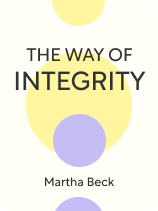

This article is an excerpt from the Shortform book guide to "The Way of Integrity" by Martha Beck. Shortform has the world's best summaries and analyses of books you should be reading.
Like this article? Sign up for a free trial here.
How can you embrace and foster positive change in your life? What should you expect in your journey of transformation?
When you commit yourself to a life of integrity, you’ll change. Martha Beck shares four ways to leverage that transformation for maximum impact: embrace the unknown, embrace unity and connectedness, find a higher purpose, and spread alignment (integrity) to others.
Read more to understand these aspects of personal change management and learn how to put them to work in your life.
Personal Change Management
Beck argues that, as you practice integrity, you might find yourself changing in ways that you didn’t expect. Your nature may call you to a higher sense of purpose and a higher spiritual awareness of the world around you. Beck calls on you to trust your process and embrace this transformation, even though its outcomes may be uncertain. She gives four pieces of advice for personal change management.
1) Embrace the Unknown
Beck encourages you to allow yourself to be open to aspects of life and experience that you don’t fully understand. She argues that living in alignment with your true nature won’t simply help you become healthier and happier—it may also lead you to a higher spiritual awareness. This will require an openness to unknown experiences because the spiritual aspects of your life and world may be unfamiliar and unknown to you, especially if you have been living in misalignment. Just because you don’t fully know what you are experiencing doesn’t mean you can’t continue trusting the process and being receptive to new spiritual experiences.
| What Is “Spirituality?” Beck argues that the path of integrity leads not simply to better psychological health and well-being, but also to a greater state of spiritual enlightenment. However, the term “spiritual” can mean very different things depending on the context. Reviewing a few common understandings of the term will shed light on Beck’s ideas. • The term “spiritual” comes from the Latin spiritus, originally meaning “breath” or “wind.” To this day, the term carries a sense of both “life force” and “non-materiality” that hearken back to these roots. • Some define spirituality as a set of emotional experiences, particularly a sense of awe, wonder, acceptance, and inner peace. • Others define spirituality as a sense of greater connection, either to the world around us, to a higher power, or to something greater than ourselves. • Finally, others define spirituality as an experience of deeper connection to one’s own sense of values and purpose—an experience of clarity about the source of one’s meaning in life. |
2) Embrace Unity and Connectedness
As you embrace your true nature and find yourself ascending to new levels of spiritual awareness, you will find the divisions between yourself and the rest of the universe becoming less important. Beck argues that interconnectedness is the true nature of the world and that we learn from culture to put boundaries between ourselves and the universe. Beck argues that, the more we get in touch with our true natures, the more we will experience belonging and connection as part of a vast, interconnected unity.
| Religious Teachings on Interconnectedness and Unity In arguing that higher spiritual awareness will lead to a greater sense of interconnectedness, Beck implicitly draws on a range of religious traditions that have proclaimed a “oneness” or “unity” of the world. • In the Tao Te Ching, Lao Tzu argues that the Tao is an eternal force manifest in all things, and that the highest spiritual state is to harmonize your life with the Tao. • Some Hindu traditions proclaim that there is a universal soul called atman, and that spiritual practice allows you to commune or fuse with this single universal soul. • The Buddhist concept of sunyata posits a philosophy of “non-dualism”—a rejection of distinctions between the objects or entities of the world in favor of a single, undifferentiated whole. |
3) Find a Higher Purpose
Beck notes that, as you become more aligned with yourself, you may discover opportunities to contribute and help others that would have never occurred to you while you were living in misalignment. This happens for several reasons. As you become at peace with yourself, you won’t use up as much energy trying to control your life and emotions. This creates an opportunity to become less self-focused and more other-focused. For example, if you’re not spending all of your time managing cognitive dissonance or ruminating on your emotional anguish, you might notice opportunities to volunteer in your community.
Second, as you become more aware of your interconnectedness with others, you will naturally become more alert to opportunities to contribute. Beck advises you to embrace these opportunities and live out a higher purpose for yourself by helping others.
| How to Find Meaning in Life In Man’s Search for Meaning, Victor Frankl builds on the idea that you can find meaning in your life by looking at the world around you. He argues that life doesn’t have one single, inherent meaning, but instead each of us has opportunities to make meaningful contributions that only exist in certain moments and contexts of our lives. A meaningful life, he asserts, lies in recognizing these opportunities and taking them as they come, which Beck might argue is easier to do once you are living with integrity. Frankl suggests three paths to finding meaning: 1. Actions: A meaningful action is one that contributes to something larger than yourself, like a community, family, or cause. 2. Experiences: People find meaning in positive experiences, such as feelings of love toward others, experiences of beauty in nature and art, or experiencing truth through learning and contemplation. 3. Responses to adversity: Frankl writes that when people experience suffering or setbacks in life, they can find meaning in these events based on how they respond. Someone who sees their hardship as an opportunity to grow will find meaning in the suffering they experienced along the way. |
4) Spread Alignment to Others
Finally, Beck argues that, as you become more aligned with yourself, you have an opportunity to spread the influence of alignment to others around you. She describes the process of spreading alignment from yourself to others as similar to the repetition of shapes in a fractal.
Recall that the discovery of false beliefs often comes from encountering a teacher—someone who has found integrity and is already free to be themselves. Once you begin living in greater alignment with yourself, you have the opportunity to be that teacher for others. Beck argues that becoming aligned doesn’t simply benefit you. Being the best version of yourself contributes to creating a greater culture of alignment around you, spreading health and spiritual transformation throughout the world.
| Modeling the Spread of Alignment Beck describes the spread of alignment as a fractal—an infinite pattern that is self-similar at different scales. However, this refers to the finished shape, while she is mainly describing a process of spreading. We might more effectively describe this process as a “cascade effect.” Also sometimes called a “domino” or “ripple” effect, a cascade occurs when an action triggers the conditions that enable the same action to occur again. For example, in ecology, the extinction of one species can cause the extinction of other species that relied on it for food, moving up the food chain in a cascade of extinctions. This can also move in the opposite direction: The decomposition of a plant can add nutrients to the soil, allowing for the growth of new plants that will eventually die and enrich the soil themselves. Therefore, by finding our own alignment, each of us has the opportunity to participate in a cascade that could spread alignment far beyond ourselves. |

———End of Preview———
Like what you just read? Read the rest of the world's best book summary and analysis of Martha Beck's "The Way of Integrity" at Shortform.
Here's what you'll find in our full The Way of Integrity summary:
- How to know if you're living in alignment with your true self
- How messages from our culture tell us to chase things we don't really want
- The four stages of realigning your life to find happiness






